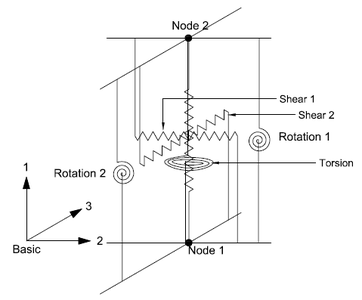ElastomericX
This command is used to construct an ElastomericX bearing element object in three-dimension. The 3D continuum geometry of an elastomeric bearing is modeled as a 2-node, 12 DOF discrete element. This elements extends the formulation of Elastomeric_Bearing_(Plasticity)_Element (or Elastomeric_Bearing_(Bouc-Wen)_Element) elements, however, instead of an user providing material models as input arguments, it only takes geometric and material properties of an elastomeric bearing as arguments. The material models in six direction are formulated within the element from input arguments, which also includes a new material model of behavior of elastomeric bearing under cyclic tension. In addition to behavior captured by existing Elastomeric_Bearing_(Plasticity)_Element (or Elastomeric_Bearing_(Bouc-Wen)_Element) elements, this element can capture the following:
- Coupled bidirectional motion in horizontal directions
- Coupling of vertical and horizontal motion
- Cavitation and post-cavitation behavior in tension
- Strength degradation in cyclic tensile loading due to cavitation
- Variation in critical buckling load capacity due to lateral displacement
For the full capabilities of this elements, users are referred to: EESD Article
The syntax of command to use this element in a 3D problem:
| element ElastomericX $eleTag $Nd1 $Nd2 $qRubber $uh $Gr $Kbulk $D1 $D2 $ts $tr $n <<$x1 $x2 $x3> $y1 $y2 $y3> <$kc> <$PhiM> <$ac> <$sDratio> <$m> <$cd> <$tc> |
| $eleTag | unique element object tag |
| $Nd1 $Nd2 | end nodes |
| $qRubber | yield strength |
| $uh | yield deformation |
| $Gr | shear modulus of elastomeric bearing |
| $Kbulk | bulk modulus of rubber |
| $D1 | internal diameter |
| $ts | single steel shim layer thickness |
| $tr | single rubber layer thickness |
| $n | number of rubber layers |
| $x1 $x2 $x3 | vector components in global coordinates defining local x-axis (optional) |
| $y1 $y2 $y3 | vector components in global coordinates defining local y-axis (optional) |
| $kc | cavitation parameter (optional, default = 10.0) |
| $PhiM | damage parameter (optional, default = 0.5) |
| $ac | strength reduction parameter (optional, default = 1.0) |
| $sDratio | shear distance from iNode as a fraction of the element length (optional, default = 0.5) |
| $m | element mass (optional, default = 0.0) |
| $cd | viscous damping parameter (optional, default = 0.0) |
| $tc | cover thickness (optional, default = 0.0) |
An example use of this element can be found here: File:DA.tcl
In this file a gravity load and a lateral offset is applied to the bearing. Then results are compared to the values that I had obtained my machine by displaying "Success" or "Failure"
References
- Kumar, M., Whittaker, A., and Constantinou, M. (2014). "An advanced numerical model of elastomeric seismic isolation bearings." Earthquake Engineering & Structural Dynamics, Published online, DOI: 10.1002/eqe.2431.

